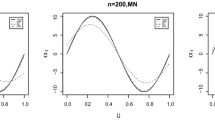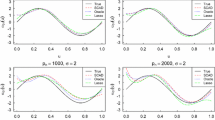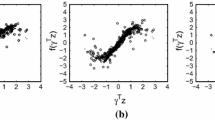Abstract
Semiparametric partially linear varying coefficient models (SPLVCM) are frequently used in statistical modeling. With high-dimensional covariates both in parametric and nonparametric part for SPLVCM, sparse modeling is often considered in practice. In this paper, we propose a new estimation and variable selection procedure based on modal regression, where the nonparametric functions are approximated by \(B\)-spline basis. The outstanding merit of the proposed variable selection procedure is that it can achieve both robustness and efficiency by introducing an additional tuning parameter (i.e., bandwidth \(h\)). Its oracle property is also established for both the parametric and nonparametric part. Moreover, we give the data-driven bandwidth selection method and propose an EM-type algorithm for the proposed method. Monte Carlo simulation study and real data example are conducted to examine the finite sample performance of the proposed method. Both the simulation results and real data analysis confirm that the newly proposed method works very well.

Similar content being viewed by others
References
Cai, Z., Xiao, Z. (2012). Semiparametric quantile regression estimation in dynamic models with partially varying coefficients. Journal of Econometrics, 167, 413–425.
Cai, Z., Fan, J., Li, R. (2000). Efficient estimation and inference for varying-coefficient models. Journal of the American Statistical Association, 95, 888–902.
Candes, E., Tao, T. (2007). The Dantzig selector: statistical estimation when \(p\) is much larger than \(n\). The Annals of Statistics, 35, 2313–2351.
Cheng, M., Zhang, W., Chen, L. (2009). Statistical estimation in generalized multiparameter likelihood models. Journal of the American Statistical Association, 104, 1179–1191.
Fairfield, K., Fletcher, R. (2002). Vitamins for chronic disease prevention in adults: scientific review. The Journal of the American Medical Association, 287, 3116–3126.
Fan, J., Gijbels, I. (1996). Local polynomial modelling and its application. New York: Chapman and Hall.
Fan, J., Huang, T. (2005). Profile likelihood inferences on semiparametric varying-coefficient partially linear models. Bernoulli, 11, 1031–1057.
Fan, J., Li, R. (2001). Variable selection via nonconcave penalized likelihood and its oracle properties. Journal of the American Statistical Association, 96, 1348–1360.
Fan, J., Zhang, W. (1999). Statistical estimation in varying coefficient models. The Annals of Statistics, 27, 1491–1518.
Fan, J., Zhang, W. (2000). Simultaneous confidence bands and hypotheses testing in varying-coefficient models. Scandinavian Journal of Statistics, 27, 715–731.
Hastie, T., Tibshirani, R. (1993). Varying-coefficient model. Journal of the Royal Statistical Society, Series B, 55, 757–796.
Huang, J., Wu, C., Zhou, L. (2002). Varying-coefficient models and basis function approximation for the analysis of repeated measurements. Biometrika, 89, 111–128.
Kai, B., Li, R., Zou, H. (2011). New efficient estimation and variable selection methods for semiparametric varying-coefficient partially linear models. The Annals of Statistics, 39, 305–332.
Lam, C., Fan, J. (2008). Profile-kernel likelihood inference with diverging number of parameters. The Annals of Statistics, 36, 2232–2260.
Lee, M. (1989). Mode regression. Journal of Econometrics, 42, 337–349.
Leng, C. (2009). A simple approach for varying-coefficient model selection. Journal of Statistical Planning and Inference, 139, 2138–2146.
Li, J., Palta, M. (2009). Bandwidth selection through cross-validation for semi-parametric varying-coefficient partially linear models. Journal of Statistical Computation and Simulation, 79, 1277–1286.
Li, J., Zhang, W. (2011). A semiparametric threshold model for censored longitudinal data analysis. Journal of the American Statistical Association, 106, 685–696.
Li, J., Ray, S., Lindsay, B. (2007). A nonparametric statistical approach to clustering via mode identification. Journal of Machine Learning Research, 8, 1687–1723.
Li, Q., Huang, C., Li, D., Fu, T. (2002). Semiparametric smooth coefficient models. Journal of Business and Economic Statistics, 3, 412–422.
Li, R., Liang, H. (2008). Variable selection in semiparametric regression modeling. The Annals of Statistics, 36, 261–286.
Lin, Z., Yuan, Y. (2012). Variable selection for generalized varying coefficient partially linear models with diverging number of parameters. Acta Mathematicae Applicatae Sinica, English Series, 28, 237–246.
Lu, Y. (2008). Generalized partially linear varying-coefficient models. Journal of Statistical Planning and Inference, 138, 901–914.
Nierenberg, D., Stukel, T., Baron, J., Dain, B., Greenberg, E. (1989). Determinants of plasma levels of beta-carotene and retinol. American Journal of Epidemiology, 130, 511–521.
Schumaker, L. (1981). Splines function: basic theory. New York: Wiley.
Scott, D. (1992). Multivariate density estimation: theory, practice and visualization. New York: Wiley.
Stone, C. (1982). Optimal global rates of convergence for nonparametric regression. The Annals of Statistics, 10, 1040–1053.
Tang, Y., Wang, H., Zhu, Z., Song, X. (2012). A unified variable selection approach for varying coefficient models. Statistica Sinica, 22, 601–628.
Tibshirani, R. (1996). Regression shrinkage and selection via the LASSO. Journal of the Royal Statistical Society, Series B, 58, 267–288.
Wang, H., Zhu, Z., Zhou, J. (2009). Quantile regression in partially linear varying coefficient models. The Annals of Statistics, 37, 3841–3866.
Wang, L., Li, H., Huang, J. (2008). Variable selection in nonparametric varying-coefficient models for analysis of repeated measurements. Journal of the American Statistical Association, 103, 1556–1569.
Xia, Y., Zhand, W., Tong, H. (2004). Efficient estimation for semivarying-coefficient models. Biometrika, 91, 661–681.
Xie, H., Huang, J. (2009). SCAD-penalized regression in high-dimensional partially linear models. The Annals of Statistics, 37, 673–696.
Yao, W., Li, L. (2011). A new regression model: modal linear regression. Technical report, Kansas State University, Manhattan. http://www-personal.ksu.edu/~wxyao/
Yao, W., Lindsay, B., Li, R. (2012). Local modal regression. Journal of Nonparametric Statistics, 24, 647–663.
Zhang, C. (2010). Nearly unbiased variable selection under minimax concave penalty. The Annals of Statistics, 38, 894–942.
Zhang, W., Lee, S., Song, X. (2002). Local polynomial fitting in semivarying coefficient model. Journal of Multivariate Analysis, 82, 166–188.
Zhao, P., Xue, L. (2009). Variable selection for semiparametric varying coefficient partially linear models. Statistics and Probability Letters, 79, 2148–2157.
Zou, H. (2006). The adaptive LASSO and its oracle properties. Journal of the American Statistical Association, 101, 1418–1429.
Zou, H., Hastie, T. (2005). Regularization and variable selection via the elastic net. Journal of the Royal Statistical Society, Series B, 67, 301–320.
Zou, H., Li, R. (2008). One-step sparse estimates in nonconcave penalized like-lihood models (with discussion). The Annals of Statistics, 36, 1509–1533.
Acknowledgments
We sincerely thank two referees and associate editor for their valuable comments that has led to great improved presentation of our work.
Author information
Authors and Affiliations
Corresponding author
Additional information
The research was supported in part by National Natural Science Foundation of China (11171112, 11101114, 11201190), National Statistical Science Research Major Program of China (2011LZ051) and the Natural Science Foundation of Zhejiang Province Education Department (Y201121276).
Appendices
Appendix
To establish the asymptotic properties of the proposed estimators, the following regularity conditions are needed in this paper. For convenience and simplicity, let \(C\) denote a positive constant that may be different at different place throughout this paper.
-
(C1) The index variable \(U\) has a bounded support \(\Omega \) and its density function \(f_U(\cdot )\) is positive and has a continuous second derivative. Without loss of generality, we assume \(\Omega \) be the unit interval [0,1].
-
(C2) The varying coefficient functions \(\alpha _1(u), \ldots , \alpha _p(u)\) are \(r\)th continuously differentiable on [0,1], where \(r\!>\!2\).
-
(C3) Let \(\Sigma _1(u)=\mathrm{E}\{\mathbf{X X}^T|U=u\}\), \(\Sigma _2(u)=\mathrm{E}\{\mathbf{Z Z}^T|U=u\}\) be continuous with respect to \(u\). Furthermore, for given \(u\), \(\Sigma _1(u)\) and \(\Sigma _2(u)\) are positive definite matrix, and their eigenvalues are bounded. In addition, we assume \(\max _i\Vert \mathbf{X}_i\Vert /\sqrt{n}=o_p(1)\) and \(\max _i\Vert \mathbf{Z}_i\Vert /\sqrt{n}=o_p(1)\).
-
(C4) Let \(t_1,\ldots ,t_K\) be the interior knots of [0,1]. Moreover, let \(t_0=0\), \(t_{K+1}=1\), \(\xi _i=t_i-t_{i-1}\) and \(\xi =\max \{\xi _i\}\). Then, there exists a constant \(C_0\) such that
$$\begin{aligned} \frac{\xi }{\min \{\xi _i\}}\le C_0, \quad \max \{|\xi _{i+1}-\xi _i|\}=o(K^{-1}). \end{aligned}$$ -
(C5) \(F(x,z,u,h)\) and \(G(x,z,u,h)\) are continuous with respect to \((x,z,u)\).
-
(C6) \(F(x,z,u,h)<0\) for any \(h>0\).
-
(C7) \(\mathrm{E}(\phi ^{\prime }_h(\varepsilon )|\mathbf{x,z},u)=0\) and \(\mathrm{E}(\phi ^{\prime \prime }_h(\varepsilon )^2|\mathbf{x,z},u)\), \(\mathrm{E}(\phi ^{\prime }_h(\varepsilon )^3|\mathbf{x,z},u)\) and \(\mathrm{E}(\phi ^{\prime \prime \prime }_h(\varepsilon )|\mathbf{x,z},u)\) are continuous with respect to \(x\).
-
(C8) \(\mathrm{liminf}_{n\rightarrow \infty } \mathrm{liminf}_{\Vert {\varvec{\gamma }}_j\Vert _H\rightarrow 0^+} {\lambda _{1j}}^{-1}{p^{\prime }_{\lambda _{1j}}(\Vert {\varvec{\gamma }}_j\Vert _H)}>0, j=s_1,\ldots ,p\), and \(\mathrm{liminf}_{n\rightarrow \infty } \mathrm{liminf}_{\beta _k\rightarrow 0^+} {\lambda _{2k}}^{-1} {p^{\prime }_{\lambda _{2k}}(|\beta _k|)}>0, k=s_2,\ldots ,d\).
Remark 4
The conditions (C1)–(C3) are similar adopted for the SPLVCM, such as in Fan and Huang (2005), Li and Liang (2008) and Zhao and Xue (2009). Condition (C4) implies that \(c_0,\ldots ,c_{K+1}\) is a \(C_0\)-quasi-uniform sequence of partitions of [0,1]. (C5)–(C7) are used in modal nonparametric regression in Yao et al. (2012). The condition \(\mathrm{E}(\phi ^{\prime }_h(\varepsilon )|\mathbf{x,z},u)=0\) ensures that the proposed estimate is consistent and it is satisfied if the error density is symmetric about zero. However, we do not require the error distribution to be symmetric about zero. If the assumption \(\mathrm{E}(\phi ^{\prime }_h(\varepsilon )|\mathbf{x,z},u)=0\) does not hold, the proposed estimate is actually estimating the function \(\tilde{m}(\mathbf{x,z},u)=\mathrm{argmin}_m\mathrm{E}(\phi _h(Y-m)|\mathbf{x,z},u)\). Condition (C8) is the assumption about the penalty function, which is similarly to that used in Fan and Li (2001), Li and Liang (2008) and Zhao and Xue (2009).
Proof of Theorem 1
Proof
Let \(\delta =n^{-r/(2r+1)}+a_n\) and \(\mathbf{v}=(\mathbf{v}_1^T,\mathbf{v}_2^T)^T\) be a vector, where \(\mathbf{v}_1\) is \(d\)-dimension vector and \(\mathbf{v}_2\) is \(p\times q\)-dimension vector, \(q=K+\hbar +1\). Define \({\varvec{\beta }}={\varvec{\beta }}_0+\delta \mathbf{v}_1\) and \({\varvec{\gamma }}={\varvec{\gamma }}_0+\delta \mathbf{v}_2\), where \({\varvec{\gamma }}_0\) is the best approximation of \(\alpha (u)\) in the \(B\)-spline space. We first show that, for and any given \(\varrho >0\), there exists a large \(C\) such that
where \(\mathcal{L }({\varvec{\gamma }},{\varvec{\beta }})\) is defined in (7). Let \(\Xi ({\varvec{\gamma }},{\varvec{\beta }})=\frac{1}{K} \{\mathcal{L }({\varvec{\gamma }},{\varvec{\beta }})- \mathcal{L }({\varvec{\gamma }}_0,{\varvec{\beta }}_0)\}\), then by Taylor expansion, we have that
where \(\zeta _i\) is between \(\varepsilon _i+\mathbf{X}_i^TR(U_i)\) and \(\varepsilon _i+\mathbf{X}_i^TR(U_i)-\delta (\mathbf{Z}_i^T\mathbf{v}_1+\mathbf{W}_i^T\mathbf{v}_2)\),
By the condition (C1), (C2) and Corollary 6.21 in Schumaker (1981), we have
Then, by Taylor expansion, we have
where \(\varepsilon _i^*\) is between \(\varepsilon _i\) and \(\varepsilon _i+\mathbf{X}_i^TR(U_i)\).
Invoking condition (C4) and (C7), after some direct calculations, we get
Hence, we have \(I_1=O_p(n\delta K^{-(r+1)}\Vert \mathbf{v}\Vert )=O_p(n\delta ^2K^{-1}\Vert \mathbf{v}\Vert )\).
For \(I_2\), we can prove
Therefore, by choosing a sufficiently large \(C\), \(I_2\) dominates \(I_1\) uniformly \(\Vert \mathbf{v}\Vert =C\).
Similarly, we can prove that
By the condition \(a_n\rightarrow 0\), hence \(\delta \rightarrow 0\). It follows that \(\delta \Vert \mathbf{v}\Vert \rightarrow 0\) with \(\Vert \mathbf{v}\Vert =C\), which lead to \(I_3=o_p(J_2)\). Therefore, \(I_3\) is also dominated by \(I_2\) in \(\Vert \mathbf{v}\Vert =C\).
Moreover, invoking \(p_\lambda (0)=0\), and by the standard argument of the Taylor expansion, we get that
Then, by the condition \(b_n\rightarrow 0\), it is easy to show that \(I_5\) is dominated by \(I_2\) uniformly in \(\Vert \mathbf{v}\Vert =C\). With the same argument, we can prove that \(I_4\) is also dominated by \(I_2\) uniformly in \(\Vert \mathbf{v}\Vert =C\).
By the condition (C6), we know that \(F(\mathbf{x,z},u,h)<0\), hence by choosing a sufficiently large \(C\), we have \(\Xi ({\varvec{\gamma }},{\varvec{\beta }})<0\), which implies that with the probability at least \(1-\varrho \), (14) holds. Hence, there exists a local maximizer such that
which completes the proof of part (i).
Now, we prove part (ii). Note that
where \(H=\int _0^1 B(u)B^T(u)\mathrm{d}u\). Invoking \(\Vert H\Vert =O(1)\) and (16), we have
In addition, it is easy to show that
Consequently, \(\Vert \hat{\alpha }_j(\cdot )-\alpha _{j0}\Vert =O_p\left( n^{\frac{-r}{2r+1}}+a_n\right) , j=1,\ldots ,p,\) which complete the proof of part (ii). \(\square \)
Proof of Theorem 2
Proof
By the property of SCAD penalty function, \(a_n=0\) as \(\lambda _{\max }\rightarrow 0\). Then by Theorem 1, it is sufficient to show that, when \(n\rightarrow \infty \), for any \({\varvec{\gamma }}\) that satisfies \(\Vert {\varvec{\gamma }}-{\varvec{\gamma }}_0\Vert =O_p(n^{-r/(2r+1)})\), \(\beta _k\) that satisfies \(\Vert \beta _k-\beta _{k0}\Vert =O_p(n^{-r/(2r+1)}), k=1,\ldots ,s_2\), and some given small \(\nu =Cn^{-r/(2r+1)}\), with probability tending to 1 we have
and
Consequently, (17) and (18) imply the maximizer of \({\mathcal{L }}({\varvec{\gamma }},{\varvec{\beta }})\) attains at \(\beta _k=0, \ k=s_2+1,\ldots ,d\).
By a similar proof of Theorem 1, we can show that
where \(\eta _i\) is between \(Y_i-\mathbf{W}_i^T{\varvec{\gamma }}-\mathbf{Z}_i^T{\varvec{\beta }}\) and \(\varepsilon _i+\mathbf{X}_i^TR(U_i)\).
By the condition (C8), \(\mathrm{liminf}_{n\rightarrow \infty } \mathrm{liminf}_{\beta _k\rightarrow 0^+} {\lambda _{2k}}^{-1} {p^{\prime }_{\lambda _{2k}}(|\beta _k|)}\!>\!0\), and \(\lambda _{2k}n^{\frac{r}{2r+1}}\!>\lambda _{\min }n^{\frac{r}{2r+1}} \rightarrow \infty \), the sign of the derivation is completely determined by that of \(\beta _k\), then (17) and (18) hold. This completes the proof of part (i).
For part (ii), apply the similar techniques as in part (i), we have, with probability tending to 1, that \(\hat{\alpha }_{j}(\cdot )=0, j=s_1+1,\ldots ,p\). Invoking \(\sup _u\Vert B(u)\Vert =O(1)\), the result is achieved from \(\hat{\alpha }_j(u)=B(u)^T\hat{{\varvec{\gamma }}}_j\). \(\square \)
Proof of Theorem 3
Proof
From Theorems 1 and 2, we know that, as \(n\rightarrow \infty \), with probability tending to 1, \({\mathcal{L }}({\varvec{\gamma }},{\varvec{\beta }})\) attains the maximal value at \((\hat{{\varvec{\beta }}}_a^T, 0)^T\) and \((\hat{{\varvec{\gamma }}}_a^T, 0)^T\). Let \({\mathcal{L }}_1({\varvec{\gamma }},{\varvec{\beta }})=\partial {\mathcal{L }}({\varvec{\gamma }},{\varvec{\beta }})/\partial {\varvec{\beta }}_a\) and \({\mathcal{L }}_2({\varvec{\gamma }},{\varvec{\beta }})=\partial {\mathcal{L }}({\varvec{\gamma }},{\varvec{\beta }})/\partial {\varvec{\gamma }}_a\), then \((\hat{{\varvec{\beta }}}_a^T, 0)^T\) and \((\hat{{\varvec{\gamma }}}_a^T, 0)^T\) must satisfy following two equations
and
where “\(\circ \)” denotes the Hadamard (componentwise) product and the \(k\)th component of \(p^{\prime }_{\lambda _{2}} (|\hat{{\varvec{\beta }}}_a|)\) is \(p^{\prime }_{\lambda _{2k}} (|\hat{\beta }_{k}|), 1\le k\le s_1\); \({\varvec{\kappa }}\) is a \(q \times s_1\)-dimensional vector with its \(j\)th block subvector being \(H\frac{\hat{{\varvec{\gamma }}}_j}{\Vert \hat{{\varvec{\gamma }}}_j\Vert _H} p_{\lambda _1}^{\prime }(\Vert \hat{{\varvec{\gamma }}}_j\Vert _H)\). Applying the Taylor expansion to \(p^{\prime }_{\lambda _{2k}} (|\hat{\beta }_{k}|)\), we get that
By the condition \(b_n\rightarrow 0\) and note that \(p^{\prime }_{\lambda _{2k}} (|\hat{\beta }_{k0}|)=0\) as \(\lambda _{\max }\rightarrow 0\), some simple calculations yields
where \(\zeta _i\) is between \(\varepsilon _i\) and \(Y_i-\mathbf{W}_{ia}^T\hat{{\varvec{\gamma }}}_{a} -\mathbf{Z}_{ia}^T\hat{{\varvec{\beta }}}_{a}\), \(R^*(u)=(R_1(u),\ldots ,R_{s_1}(u))^T\). Invoking (20), and using the similar arguments to (21), we have
where \(\bar{\zeta }_i\) is also between \(\varepsilon _i\) and \(Y_i-\mathbf{W}_{ia}^T\hat{{\varvec{\gamma }}}_{a} -\mathbf{Z}_{ia}^T\hat{{\varvec{\beta }}}_{a}\).
Let \(\Phi _n=\frac{1}{n}\sum \nolimits _{i=1}^n\phi ^{\prime \prime }(\varepsilon _i)\mathbf{W}_{ia}\mathbf{W}_{ia}^T\) and \(\Psi _n=\frac{1}{n}\sum \nolimits _{i=1}^n\phi ^{\prime \prime }(\varepsilon _i)\mathbf{W}_{ia}\mathbf{Z}_{ia}^T\), then, by the result of Theorem 2 and regularity conditions (C3) and (C7), after some calculations based on (22), it follows that
where \(\Lambda _n=\frac{1}{n}\sum \nolimits _{i=1}^n\mathbf{W}_{ia}\left[ \phi ^{\prime }_h(\varepsilon _i)+\phi ^{\prime \prime }_h(\varepsilon _i) \mathbf{X}_{ia}^TR^*(U_i)\right] \). Furthermore, we can prove
Therefore, we can write
Substituting (24) into (21), we obtain
Note that
and
Hence, it is easy to show that
By the definition of \(R^*(U_i)\), we can prove \(J_2=o_p(1)\). Moreover, we have
It remains to show that
where \(\Delta =\mathrm{E}(G(\mathbf{X,Z},U,h){\check{\mathbf{Z}}}_a{ \check{\mathbf{Z}}}_a^T)\).
Then, combine (26) and (27) and use the Slutsky’s theorem, it follows that
Next, we prove (27). Note that for any vector \({\varvec{\varsigma }}\) whose components are not all zero,
where \(a_i^2=\frac{1}{n}G(\mathbf{X}_i,\mathbf{Z}_i,U_i,h){\varvec{\varsigma }}^T {\check{\mathbf{Z}}}_{ia}{\check{\mathbf{Z}}}_{ia}^T{\varvec{\varsigma }}\) and, conditioning on \(\{\mathbf{X}_i,\mathbf{Z}_i,U_i\}\), \(\xi _i\) are independent with mean zero and variance one. It follows easily by checking Lindeberg condition that if
then \(\sum _{i=1}^n a_i\xi _i/\sqrt{\sum _{i=1}^n a_i^2}\stackrel{\mathrm{d}}{\longrightarrow } N(0,1)\). Thus, we can conclude that (27) holds.
Now, we only need to show (28) holds. Noting that \(({\varvec{\varsigma }}^T {\check{\mathbf{Z}}}_{ia})^2\le \Vert {\varvec{\varsigma }}\Vert ^2\Vert {\check{\mathbf{Z}}}_{ia}\Vert ^2\), hence \(a_i^2\le \frac{1}{n}G(\mathbf{X}_i,\mathbf{Z}_i,U_i,h)\Vert {\varvec{\varsigma }}\Vert ^2 \Vert {\check{\mathbf{Z}}}_{ia}\Vert ^2\). Since
and by the conditions \(\max _i\Vert \mathbf{X}_i\Vert /\sqrt{n}=o_p(1)\) and \(\max _i\Vert \mathbf{Z}_i\Vert /\sqrt{n}=o_p(1)\) in (C3), using the property of spline basis (Schumaker 1981) and the definition \(\mathbf{W}_{ia}=I_p\otimes B(U_i)\cdot \mathbf{X}_{ia}\) together with the conditions (C5) and (C7), we can prove
Applying the Slutsky’s theorem, (28) holds obviously, which complete the proof of Theorem 3. \(\square \)
Proof of Theorem 4
Proof
According to the Eq. (24) and the asymptotic normality of \(\hat{\varvec{\beta }}_{a}-{\varvec{\beta }}_{a0}\) in Theorem 3, for any vector \(\mathbf{d}_n\) with dimension \(q\times s_1\) and components not all 0, by the conditions (C1)–(C5) and (C7) and use the Slutsky’s theorem and the property of multivariate normal distribution, it follows that
where
For any \(q\times s_1\)-vector \(\mathbf{c}_n\) whose components are not all 0, by the definition of \(\hat{\varvec{\alpha }}_a\) and \(\tilde{\varvec{\alpha }}_a\), choosing \(\mathbf{d}_n=\mathbf{W}_a^T\mathbf{c}_n\) yields
\(\square \)
About this article
Cite this article
Zhao, W., Zhang, R., Liu, J. et al. Robust and efficient variable selection for semiparametric partially linear varying coefficient model based on modal regression. Ann Inst Stat Math 66, 165–191 (2014). https://doi.org/10.1007/s10463-013-0410-4
Received:
Revised:
Published:
Issue Date:
DOI: https://doi.org/10.1007/s10463-013-0410-4




